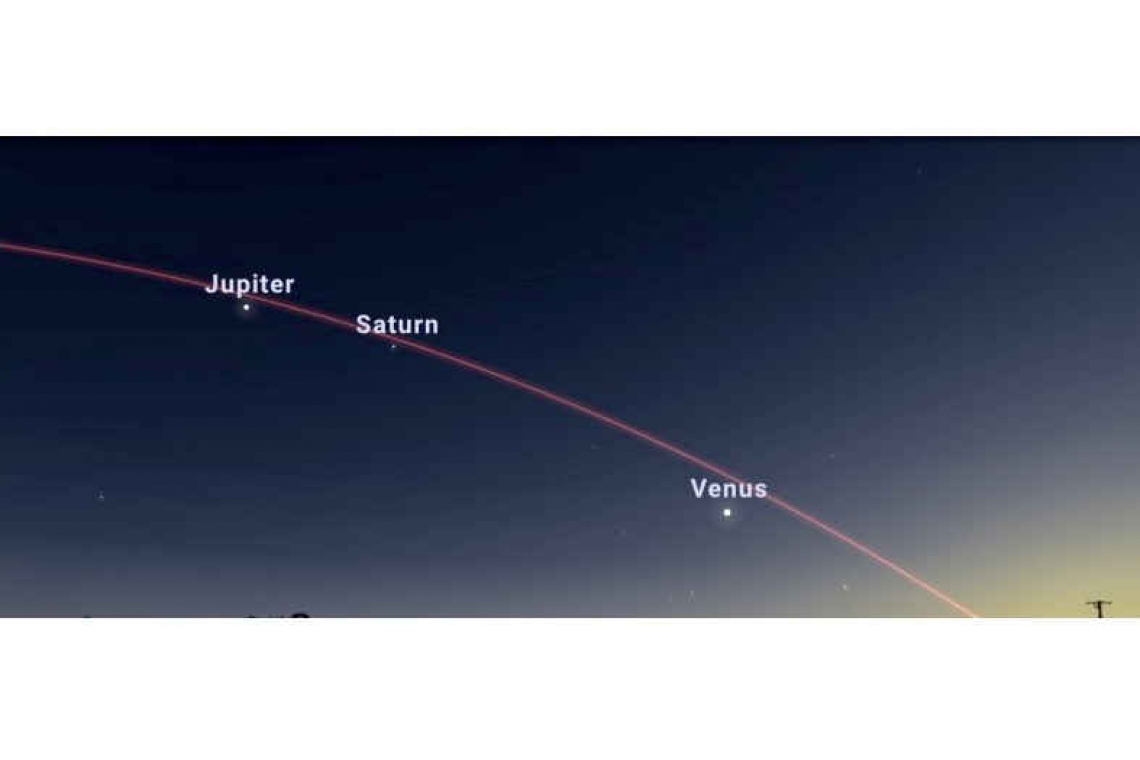~ St. Maarten’s Backyard Astronomy for December 10 – 12 ~
Sun rises at 6:25am
Sun sets at 5:37pm
Lunar phase: 2nd quarter, waxing half moon
Moon set: 12:15am
Moon rise: 12:55pm
These gentle Caribbean evenings are heaven for star gazers: the cool breeze, the velvet night, and the dazzling points of light that draw our attention to the mysterious universe that envelopes our fragile world. The magic begins with sunset and lasts all night, ending with the pink rays of dawn streaking from the eastern horizon to herald the coming daylight.
Evening star gazers will enjoy looking halfway up in the sky above the southwestern horizon to easily locate three planets: Venus, Saturn and Jupiter. These worlds are arranged across the sky in a straight line, like a slash from upper left to lower right. Get out those binoculars to explore their beauty.
Venus at the bottom right of the line is by far the brightest, and can even be seen before the sky turns fully dark. Within minutes, Jupiter begins to be visible as the sky dims, sitting at the opposite end of the line. Once you spot Venus and Jupiter, wait and watch and you will find Saturn exactly between them. On Friday and Saturday evenings, the half circle of the moon extends the same line farther up and to the left. By the way, the only bright star easily observed in the southern sky, below the line of planets and moon is a star called Fomalhaut. Known to astronomers as the Loneliest Star, Fomalhaut is a part of a dim constellation called Piscis Austrinus or Southern Fish.
The late night hours offer a parade of constellations from the eastern horizon to the zenith position (directly overhead) and eventually heading down to the western edge of the sky in the early morning hours. Beginning by looking directly up after sunset, you will find the Great Square of Pegasus. The parade from the east then elevates Andromeda and Aries – two lesser known and underappreciated constellations. Behind these two, Perseus the Hero leads the way for the more familiar constellations of the Winter Circle.
Already by 6:30pm, the constellations of Taurus and Auriga are rising up. Orion follows by about 8:30pm with Gemini close behind. By 10:00pm, you will notice the brightest true star in the entire field of the Earth's view of the star, its Sirius the Dog Star. After midnight, the parade continues with Leo rising up. Just before dawn, Leo the Lion takes the zenith position overhead with Virgo and Libra holding court at the end of the night long parade.
Those of you wondering where Mars has been hiding for the last few months may be motivated to awaken before dawn to find the red planet near the eastern horizon, just before the sky lightens. Mars has been transiting across the sun from our earthly vantage point, and thus lost from our view; but welcome him back, as Venus reigns in the Evening Star position, Mars can take a turn as the morning star for a while!
Thank you for keeping up with the Night Sky articles designed for St. Maarten sky viewing. If you are out later on in the week, each star rises about four minutes earlier each day than written here, and the moon rises 50 minutes later. Night Sky is researched and compiled by Lisa Davis-Burnett. Earthsky.org is a key resource for information and images. Questions or comments? Email This email address is being protected from spambots. You need JavaScript enabled to view it..







